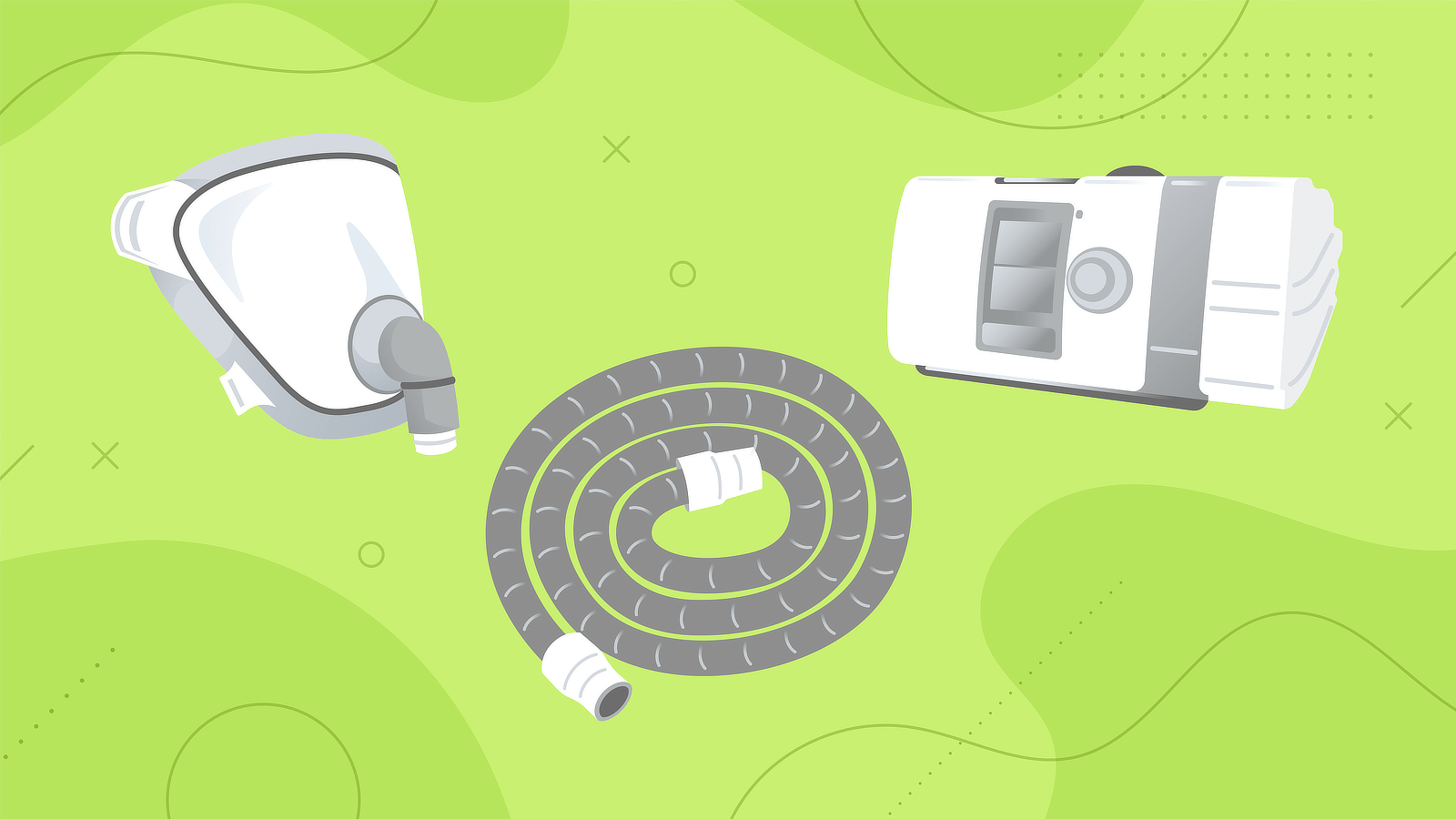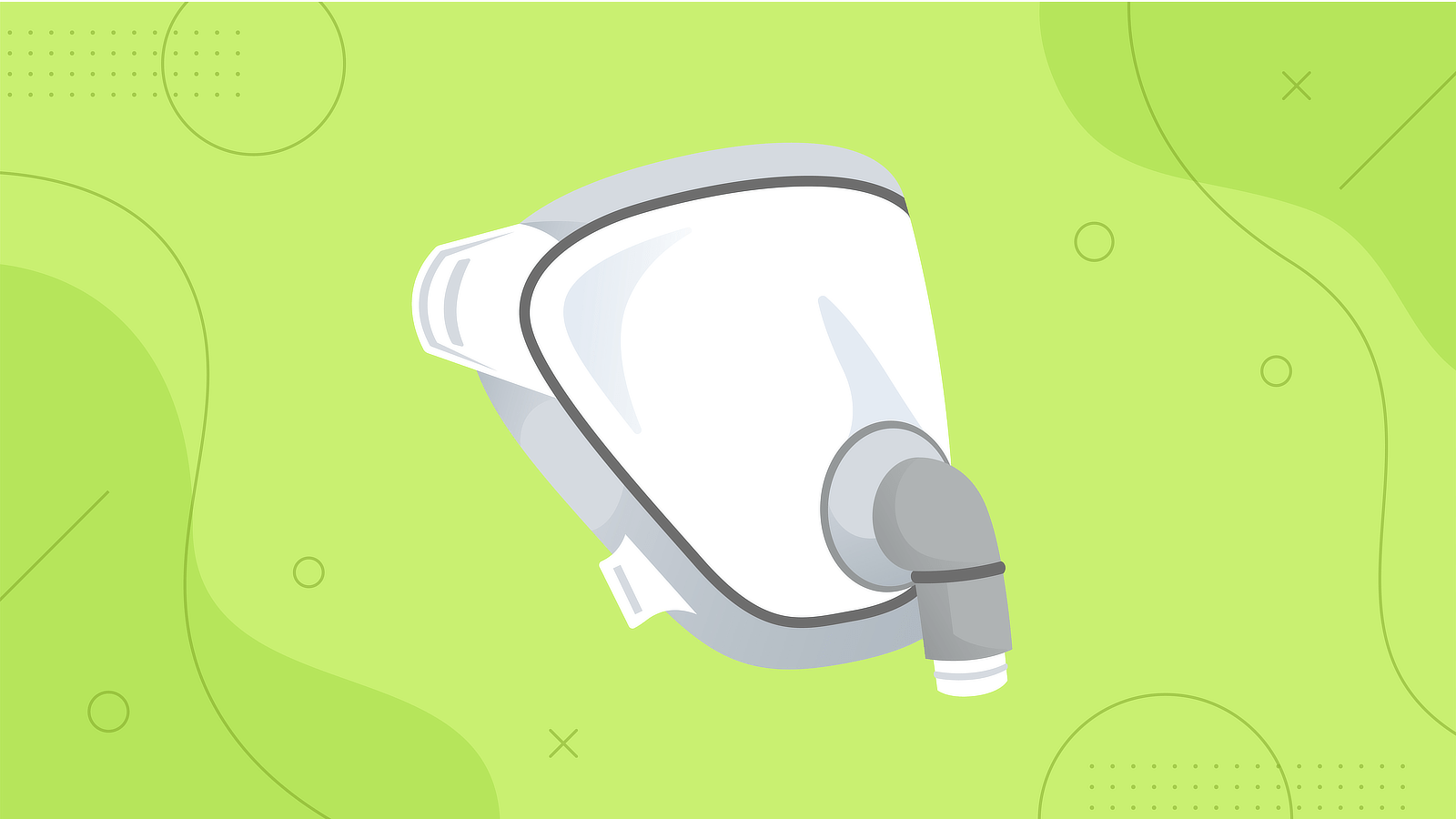A breakdown of the various pieces of your CPAP machine and how they function together to help you sleep better and live your best life

When you’re not sure what everything does, CPAP machines just might look like a crazy contraption out of a sci-fi movie or medical drama you’d see on TV.
But the way the machines work — and the functions the various parts serve — makes a lot of sense once you know some things about them.
In this guide, we’re going to break down a CPAP system into its individual components to help provide clarity about these important tools for regaining your energy, getting a good night’s sleep, and restoring your quality of life.
Three Major CPAP Equipment Sections
At a high level, most parts related to your CPAP machine fit in one of three major sections or groups.
There is:
- The CPAP machine itself and the parts directly within it.
- The CPAP mask that rests against your face.
- The CPAP hose or CPAP tube that connects the mask to the machine.
Each of these sections has multiple components which work together to impact the overall experience.
So to truly understand how everything works, what parts might need maintenance or replacement, and how to best approach common sources of discomfort, we’ll need to break things down a little further.
Section 1: The CPAP Machine
The CPAP machine is the unit you’ll place on a bedside table, nightstand, or another nearby area.
It provides the positive airway pressure (PAP) for which the machines get their name.

It’s stationary mainly with little to interact with.
However, the parts you can interact with are essential to getting the most out of your therapy.
The Machine Housing
This is the shell around your machine. It’s typically made from smooth plastic for easy clean-up and a pleasing appearance.
The housing or chassis protects the motor, power supply, and other internal components and provides a solid place to mount the controls and hose connections for easy operation.
Humidifier & Water Reservoir
The most popular CPAP machines sold today include a water reservoir and humidifier to soothe your airways while you sleep.
They help to minimize nose bleeds, nasal passage or sinus irritation, and sore throats.
They can also simply make the air more pleasant to breathe.
Your water reservoir typically slots into the chassis or attaches to one side of the machine to provide easy access.
The design also keeps things stable, so any slight bumps or movement won’t make a mess.
Filter
Filters come in both reusable and non-reusable types.
They typically slot in between the motor and CPAP tube connection to help filter out any irritants, such as pet hair, dust, dander, and even some allergens.
Be sure to consult your CPAP machine manual for details on the filter’s location and proper filter maintenance or replacement schedules.
Power Connections
Today, most CPAP machines feature a detachable power cord that plugs into the machine’s side or rear.
Many also include an in-line power supply for easy replacement should a malfunction occur.
However, some models only offer a removable cord with no power supply or even an internal power supply without a detachable cable.
Wherever possible, we recommend models with detachable cords to provide additional safety against tripping over your cord or pulling your machine over, as well as easy (and more affordable) replacement should anything go wrong.
Section 2: The CPAP Mask
Your CPAP mask has a massive influence on your overall experience.
A proper fit is essential to ensuring that you get the most from your therapy while also minimizing discomfort and helping you fall asleep more easily.

Let’s look at the various parts involved. Understanding why each part is important is critical to finding the proper mask for you.
CPAP Mask or CPAP Mask Frame
The frame is the most prominent part of the mask.
It’s essentially the structure onto which everything else connects or mounts to provide a tight seal and comfortable wear throughout the night.
In most cases, this is made from flexible but sturdy plastic.
Some masks are more rigid than others, but most offer some movement to allow the mask to shape the contours of your face and prevent damage to the CPAP mask or wearer if you toss and turn at night.
Mask Cushion
The mask cushion sits between the CPAP mask and your face.
The exact shape and configuration will depend on the type of mask you’re using.
They could look like an air-filled donut that surrounds the perimeter of your face or small separated puffs that are only slightly bigger than your nostrils.
Headgear
Mask fit is critical.
But simply making things as tight as possible isn’t the right solution.
Overtightening your mask can lead to skin irritation, headaches, and premature wear and tear on your mask components.
Your headgear is the first step in ensuring that everything fits just right.
Most headgear features multiple adjustment points so that you can optimize the fit from every direction.
It’s also typically made from a soft material that you can clean easily with mild soap and water if it gets dirty, sweaty, or smelly.
Chin Strap
Instead of holding your mask to your face, a chin strap’s role is to firmly but gently hold your mouth shut.
If you use a full-face mask, this is likely not required.
However, if you use a nasal mask or nasal pillow mask, a chin strap can help to prevent air leakage if you sleep with your mouth open or prevent you from switching to mouth breathing and bypassing your CPAP entirely.
In most cases, these straps are made from a similar material to the headgear and are soft, durable, and easily maintained with a quick hand scrubbing.
Section 3: The CPAP Tubing or CPAP Hose
Your CPAP hose is what bridges the gap between machine and mask.
While it’s technically just a tube, it’s more than that.

Let’s look at the various aspects of your CPAP tubing and why they matter.
CPAP Hose or Tube Body
The most obvious part of the hose is the body.
In most cases, this will be a ribbed tube with quick attach connectors on each end.
However, the exact dimensions and appearance will vary slightly from brand to brand and even from machine to machine.
While they might just seem like a simple hose, they’re not always universally compatible.
So be sure to check if the tubing works with your CPAP machine or CPAP mask before purchasing to confirm.
Tube Elbow or Tube Swivel
This might be considered a mask component, depending on how you look at it.
However, there is an elbow or swivel adapter for many masks where the CPAP mask and CPAP hose meet.
The elbow helps provide freedom of movement, reduce tension on the mask (and therefore your face), and ensure that the airway cannot accidentally become blocked if you move in your sleep and pinch the mask or hose.
Heating Elements
Heated CPAP tubing helps fight condensation and provides a more comfortable breathing experience when using a humidifier or operating your CPAP machine in particularly cool environments — a situation often referred to as rainout.
The elements are encased in the tubing itself.
You should never attempt to expose or modify the heating elements.
Doing so will likely damage your CPAP tubing and could cause injuries.
CPAP Tube Wraps
The heating effect might not be as strong, but if your CPAP tubing doesn’t include heating, you can often find CPAP tube wraps or hose covers which serve a similar role.
These wraps effectively reduce condensation in most cases by helping to insulate the tube from the differing ambient temperature surrounding it.
These are available through third-party makers as well as many prominent CPAP machine manufacturers.
In most cases, they’re widely compatible with a range of CPAP tube models.
Just be sure to check length and diameter before purchasing.
Closing Thoughts & Further Reading
Once you break things down to the part level, CPAP machines are much less intimidating.
Now that you have a clear picture of the various parts of your machine and the role they serve, we have several guides which offer further information.
For a deeper look at topics relating to your CPAP hardware and accessories, we recommend checking:
- The Best CPAP Mask Types for Every Type of Sleeper (Mask Types Compared)
- CPAP Machine Cleaning & Maintenance Fundamentals
- CPAP Machine Use Essentials: Proper Mask Fitment and Other Critical Considerations
Key Takeaways
- Most CPAP parts are either a part of the central unit, a part of the mask, or a part of the hoses connecting the two.
- The main unit includes the motor housing, air filters, a water reservoir, and power connections.
- The CPAP mask includes the frame of the mask itself, the mask cushion, headgear, and chin straps.
- CPAP hoses or tubing include the main hose body, tube elbows or swivels to connect the hose to the mask and ensure airflow, and heating elements or hose wraps and covers.
As Canada’s leading online CPAP store in customer satisfaction, we’re committed to helping you find the perfect solution to sleep soundly and comfortably. PAP therapy is an effective way to improve your quality of life and start the day feeling more refreshed and ready to take on the world. Whether you’re looking for a complete CPAP machine package or kit or simply need to replace some CPAP supplies, our selection of industry-leading brands has you covered. Contact us today or browse our selection to learn more!
REFERENCES:
- American Sleep Association (ASA): CPAP Parts and Supplies
- ResMed: CPAP Equipment
- HealthLine: What’s a CPAP Machine, and How Does It Work?
- WebMD: A Guide to CPAP Machines
